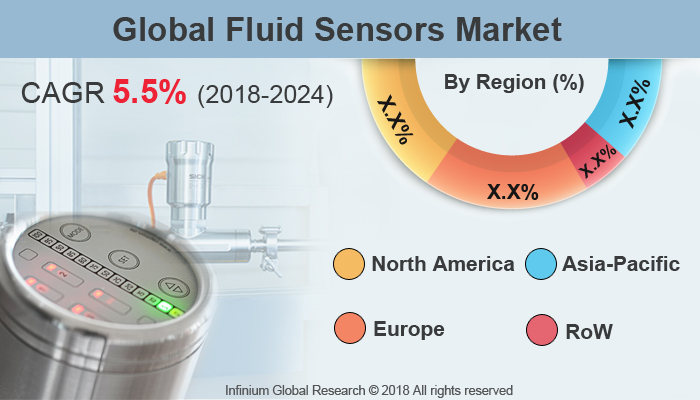Fluid Sensors Market (Detection Method - Contact and Non-contact; Product Type - Pressure Sensors, Level Sensors, Temperature Sensors, and Flow Sensors; End-use Industry - Chemical, Oil & Gas, Food and Beverages, Power Generation and Water, and Waste Water Treatment): Global Industry Analysis, Trends, Market Size and Forecasts to 2024
A recent report published by Infinium Global Research on fluid sensors market provides an in-depth analysis of segments and sub-segments in global as well as regional fluid sensors market. The study also highlights the impact of drivers, restraints and macro indicators on the global and regional fluid sensors market over the short term as well as long term. The report is a comprehensive presentation of trends, forecast and dollar values of global fluid sensors market. According to the report the global fluid sensors market is projected to grow at a CAGR of 5.5% over the forecast period of 2018-2024.
Market Insight
Fluid sensor is the sensor used to detect, monitor and measure the liquids and fluidized solids based on the gravity. Fluid sensors have very vital applications in every manufacturing and processing industry as they offer time efficiency and health security. In the food and beverages industries, fluid sensors are used to ensure the consistency of the taste and smoothness of products. In petrochemical industries, they are used in the detection of highly corrosive and acidic substances. In addition, they are used in several industries such as chemical, power generation, and water and wastewater treatment.
The rapidly growing demand for non-contact sensors from oil & gas and food and beverage industries drives the growth of fluid sensor market. In both oil and gas, industries the optical sensors are used to monitor storage tanks, hydraulic and lubricating oil reservoirs, during this process they are in contact with the various corrosive materials so they need to be replaced within a short period. In addition, both contact and non-contact fluid sensors are majorly used in the water and wastewater treatment. Rising water and wastewater treatment industry across the world is likely to escalate the growth of fluid sensors market. Moreover, growing digitalization and adoption of wireless fluid sensors for remote sensing applications are projected to create several opportunities for the fluid sensor market in upcoming years.
Geographically, North America holds the largest market share in the fluid sensor market in 2017 and is expected to be the foremost market over the forecast period. In addition, various government agencies are taking initiative to improve the water and the wastewater treatment industries that create a huge demand for water level measurement equipment such as Fluid sensors in North America.
In addition, the Asia Pacific region is the fastest growing region in the fluid sensor market. The rapidly growing oil, gas, food and beverages, water and wastewater treatment industries in this region are likely to boost the growth of the fluid market in the Asia Pacific region.

Segment Covered
The report on global fluid sensors the market covers segments such as detection method, product type, and end-use industry. On the basis of the detection method the global fluid sensors market is categorized into contact and non-contact. On the basis of product type, the global fluid sensors market is categorized into pressure sensors, level sensors, temperature sensors, and flow sensors. On the basis of end-use industry, the global fluid sensors market is categorized into chemical, oil & gas, food and beverages, power generation and water and wastewater treatment.
Geographic Coverage
The countries covered in the North America region includes the U.S., Canada, and Mexico; while Asia-Pacific includes China, Japan, India, South Korea, Malaysia, and among others. Moreover, Germany, U.K., France, Spain, and Rest of Europe are included in the European region. The U.S. drives the growth in the North America region, as it is the largest market in the region. The Asia-pacific region offers substantial potential for the market growth owing to rapid growth in markets such as India and China. The APAC region is projected to experience growth at a CAGR of x.x% over the period of 2018-2024.
Companies Profiled:
The report provides profiles of the companies in the global fluid sensors market such as Schneider Electric AG, Honeywell Corporation, Infineon Technology, BOSCH, SICK AG, Sensirion AG, Futek Advanced Sensor Technologies, Yokogawa Electric Corporation, General Electric Company and Others.
Report Highlights:
The report provides deep insights on demand forecasts, market trends, and micro and macro indicators. In addition, this report provides insights into the factors that are driving and restraining the global fluid sensors market. Moreover, IGR-Growth Matrix analysis given in the report brings insight into the investment areas that existing or new market players can consider. The report provides insights into the market using analytical tools such as Porter's five forces analysis and DRO analysis of fluid sensors market. Moreover, the study highlights current market trends and provides forecast from 2018-2024. We also have highlighted future trends in the fluid sensors market that will impact the demand during the forecast period. Moreover, the competitive analysis given in each regional market brings insight into the market share of the leading players. This report will help manufacturers, suppliers, and distributors of the fluid sensors market to understand the present and future trends in this market and formulate their strategies accordingly.
